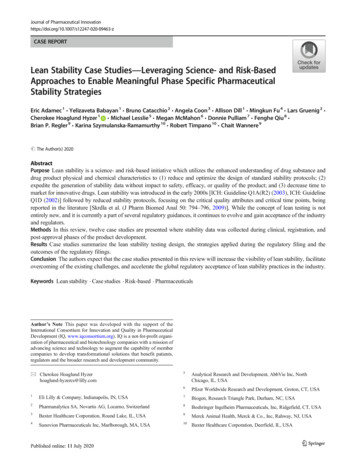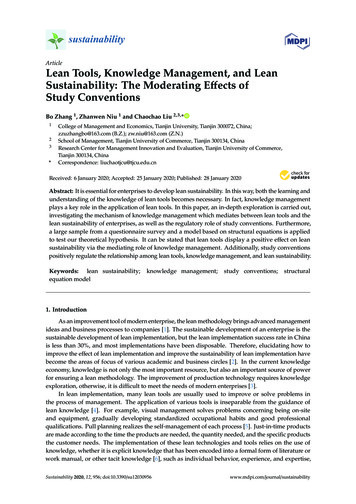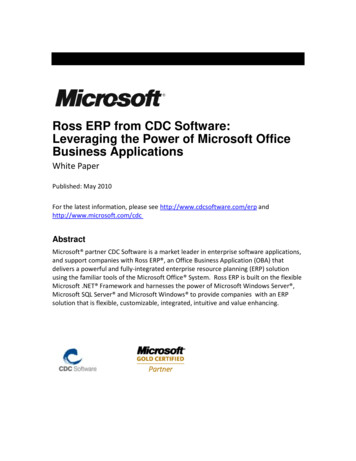
Transcription
Journal of Pharmaceutical -zCASE REPORTLean Stability Case Studies—Leveraging Science- and Risk-BasedApproaches to Enable Meaningful Phase Specific PharmaceuticalStability StrategiesEric Adamec 1 & Yelizaveta Babayan 1 & Bruno Catacchio 2 & Angela Coon 3 & Allison Dill 1 & Mingkun Fu 4 & Lars Gruenig 2 &Cherokee Hoaglund Hyzer 1 & Michael Lesslie 5 & Megan McMahon 6 & Donnie Pulliam 7 & Fenghe Qiu 8 &Brian P. Regler 9 & Karina Szymulanska-Ramamurthy 10 & Robert Timpano 10 & Chait Wannere 9# The Author(s) 2020AbstractPurpose Lean stability is a science- and risk-based initiative which utilizes the enhanced understanding of drug substance anddrug product physical and chemical characteristics to (1) reduce and optimize the design of standard stability protocols; (2)expedite the generation of stability data without impact to safety, efficacy, or quality of the product; and (3) decrease time tomarket for innovative drugs. Lean stability was introduced in the early 2000s [ICH: Guideline Q1A(R2) (2003), ICH: GuidelineQ1D (2002)] followed by reduced stability protocols, focusing on the critical quality attributes and critical time points, beingreported in the literature [Skrdla et al. (J Pharm Biomed Anal 50: 794–796, 2009)]. While the concept of lean testing is notentirely new, and it is currently a part of several regulatory guidances, it continues to evolve and gain acceptance of the industryand regulators.Methods In this review, twelve case studies are presented where stability data was collected during clinical, registration, andpost-approval phases of the product development.Results Case studies summarize the lean stability testing design, the strategies applied during the regulatory filing and theoutcomes of the regulatory filings.Conclusion The authors expect that the case studies presented in this review will increase the visibility of lean stability, facilitateovercoming of the existing challenges, and accelerate the global regulatory acceptance of lean stability practices in the industry.Keywords Lean stability . Case studies . Risk-based . PharmaceuticalsAuthor’s Note This paper was developed with the support of theInternational Consortium for Innovation and Quality in PharmaceuticalDevelopment (IQ, www.iqconsortium.org). IQ is a not-for-profit organization of pharmaceutical and biotechnology companies with a mission ofadvancing science and technology to augment the capability of membercompanies to develop transformational solutions that benefit patients,regulators and the broader research and development community.* Cherokee Hoaglund Hyzerhoaglund-hyzercs@lilly.com5Analytical Research and Development, AbbVie Inc, NorthChicago, IL, USA6Pfizer Worldwide Research and Development, Groton, CT, USA1Eli Lilly & Company, Indianapolis, IN, USA7Biogen, Research Triangle Park, Durham, NC, USA2Pharmanalytica SA, Novartis AG, Locarno, Switzerland8Boehringer Ingelheim Pharmaceuticals, Inc, Ridgefield, CT, USABaxter Healthcare Corporation, Round Lake, IL, USA9Merck Animal Health, Merck & Co., Inc, Rahway, NJ, USASunovion Pharmaceuticals Inc, Marlborough, MA, USA10Baxter Healthcare Corporation, Deerfield, IL, USA34
J Pharm InnovIntroductionThis manuscript is intended to encourage risk-based decisionmaking in stability testing and to further drive for implementation of lean stability strategies through delineation of casestudies from recently accepted practices. Lean stability is ascience- and risk-based approach that leverages enhancedknowledge about the stability behavior of a product to focusstability programs on the highest risk attributes and timepoints. Application of lean stability concepts enables moreefficient, product-specific stability studies and is fully alignedwith modern approaches toward product and process development [1], leading to a reduced protocol compared to a standard, ICH Q1A-type program. The concept of lean stabilityhas been applied for over two decades, beginning with theICH (Q1A(R2), Q1D) guidance allowing for bracketing andmatrixing during stability testing [2], and continuing into laterICH (Q8–12) and WHO guidances stipulating the acceptability of scientifically driven approaches towards meeting stability requirements [1, 3–7]. The concept of reducing the testingplan to include only critical attributes that define the product’sstability and performance over time have been previouslypublished [8–10]. While these approaches have primarilyhad positive regulatory responses [11], they have not beenincluded in regulations to date.In 2016, the International Consortium for Innovation andQuality in Pharmaceutical Development (IQ) launched thelean stability working group focused on increasing the understanding and acceptance of science- and risk-based protocolstrategies. The working group has approximately 20 membersfrom 14 companies across the pharmaceutical industry whohave contributed the case studies contained in this paper. Thecompanies represent development and manufacture of multiple dosage forms (e.g., solid oral, parenteral, combinationproducts) and support stability strategies throughout the product life cycle (i.e. drug substances, drug products) across pharmaceutical product modalities (e.g., small molecules, biologics, etc.). These case studies demonstrate how industryhas successfully expanded beyond the strategies initially defined in the ICH Q1 guidance as well as provide insight towards how to continually improve efficiency within stabilitystudies and product understanding throughout the product development life cycle: clinical development, registration phase,and post-approval. The lean stability strategy is dependentupon a robust understanding of the product design and/orprofile, and considers existing data from development or accelerated studies, risk-based predictive stability, and literature.Industry spends unnecessary resources initiating and maintaining long-term stability protocols that include non-stabilityindicating tests and non-value-added time points throughoutthe product’s life cycle. Implementing lean stability strategiesrequires the adjustment of stability protocols to improve efficiency and expedite results without impacting safety, efficacy,or quality of the product. Lean strategies are applicable at allstages of the product life cycle from development to marketedphase and to all pharmaceutical product types and are allowable by ICH Q1A (R2) [12] as “Alternative approaches can beused when there are scientifically justifiable reasons.” In addition, these strategies do not reduce product stability riskknowledge but rather could benefit the patient through decreasing the time to market for new medicines.An example of a lean stability approach used in the postapproval phase is shown below. A lean stability approachfocuses on using stability indicating attributes and existingstability knowledge of a drug substance or drug product tofocus on the right tests, time points, and conditions throughoutthe study. Where the overall stability is well-understood andthe drug substance or drug product stability attributes are predictable, a lean approach is warranted. Table 1 provides anexample of a standard full stability protocol and outlines typical testing attributes for a drug product. While there are manysituations where lean stability may be applied, Table 2 showsan example lean stability protocol approach for a stable roomtemperature drug product where conditions, time points, andtesting attributes have been reduced yet still provides adequatestability information. This approach would result in cost andtime savings without impacting quality and safety of the product. This is just one of many examples; conditions and timepoints may be selected based on specific product attributesand intended region of market. For example, testing at the30 C/75% RH condition, as opposed to 30 C/65% RH, toallow for global product development may not be standardpractice at all companies.This example could also apply to setting a shelf-life for astable product in the clinical phase of development. With sufficient prior knowledge, this lean approach example, and theaddition of an accelerated condition (40 C/75% RH), theproposed shelf life dating could be supported based upon results for the stability—indicating test attributes and anyTable 1Standard (full) stability protocolStorage conditionInterval (months)InitialInitial/release40 C/75% RH30 C/75% RH25 C/60% RH5 s to be applied in accordance with the above protocol include thefollowing: (A) appearance, assay, degradation products, dissolution, water content and microbiological quality; (B) appearance, assay, degradation products, dissolution and water content; (C) control sample for appearance testing
J Pharm InnovTable 2Lean stability protocolStorage conditionInterval (months)InitialInitial30 C/75% RH1224364860AAAAAAShelf-life limiting tests to be applied in accordance with the above protocol include the following: (A) appearance, assay, degradation products,and dissolutionsupporting data that may be available. Supporting data couldconsist of existing standard stability data and/or informationfrom accelerated stability approaches (risk-based predictivestability) [13–15] where the accelerated data can be statistically analyzed (e.g., ASM, ASAP, etc.)1 [15] to model shelf-lifelimiting attributes (SLLAs). It is important to note that the leanstability approach may differ from that in Table 2, customizedbased on product-specific understanding obtained from priorstability studies of critical quality attribute(s) and/or shelf-lifelimiting attribute(s).The risks to implementing such an approach include thepotential non-acceptance or queries from health authoritiesrelated to less data being collected than a standard stabilityprotocol. In order to remediate these risks, thorough risk assessments should be completed for each product to understandthe reliability of methods and uncertainty of design byleveraging previously gained knowledge.Barriers to implementing lean strategies have been experienced both internally and externally to companies within thepharmaceutical industry. The most significant hurdle colleagues have faced when proposing lean stability strategiesis internal company conservatism within several departmentsand management levels. External uncertainties such as a lackof alignment regarding regulatory positions have been reported, both between agencies and within a single agency. Effortsto influence and better understand concerns of regulatoryagencies should be made. By presenting case studies collectedfrom multiple companies, the authors hope to provide an improved understanding of lean stability approaches and thebenefit they can provide to product development.Case StudiesA lean stability strategy can take many forms. It should beproduct specific, dependent on the stage of development andreflect the product knowledge available at the time. In theclinical development phase, while development is under wayand changes and improvements are constant, this may take theform of utilizing predictive tools and/or confirmatory studies todemonstrate a change does not impact stability rather than reinitiating a long-term stability protocol, to justify re-test periodor shelf-life, or to identify which tests are stability indicating. Inthe registration phase, a lean strategy may leverage the cumulative clinical and registration stability data to justify reducingthe tests, time points and/or storage conditions that are necessary to monitor stability on an annual basis. In the postapproval phase, product knowledge and stability understandingare highest and there are many opportunities to leverage leanstrategies to support a change. Following are examples of casestudies collected during each phase of development: clinicaldevelopment, registration, and post-approval. Table 3 providesan overview of the presented case studies.Clinical DevelopmentCase Study 1In this case study, the drug substance stability data were used tosupport drug in capsule (DiC) product. The scope of the projectspanned across 5 small molecules with drug in capsule formulations. The FDA Guidance for Industry, cGMP for Phase 1Investigational Drugs (U.S. Food and Drug Administration,2008) allows representative samples of phase 1 investigationaldrugs to be used to monitor stability and quality. In the case ofDiC formulations it was determined that the drug substancestability data was representative of the DiC stability. The justification in the Clinical Trial Application (CTA) includedreferencing the Common Technical Document (CTD)Section S.7 in Section P.8. The CTA also included referenceto accelerated stability data on the drug substance as part of thejustification. Regulatory submissions were performed in theUS, France and Spain. Challenges were received in two cases(US and Spain) and the agencies requested that the DiC beplaced on long-term stability concurrent with the clinical study.Due to timing considerations, further technical discussion wasnot pursued, and the DiC was placed on long-term stability. Theprimary benefit was still realized by this approach; time savingsin not waiting for the one-month drug product stability dataprior to IND or CTA filing.The following wording was included in Section P.8 of a CTAas justification for not placing a DiC on stability, following a riskassessment to ensure the drug substance is not susceptible toincreased moisture uptake by the hydroxypropylmethylcellulose(HPMC) capsule shells.1Accelerated stability modeling (ASM) and accelerated stability assessmentprogram (ASAP) are specific approaches for performing science- and riskbased predictive stability assessments. Science- and risk-based predictive stability is defined as short-term stability studies using high temperatures (andvarying humidities) and modeling to predict stability at temperatures (anddefined humidities) intended for long-term storage conditions.Summary of Stability StudiesRepresentative batches of drug product will not be formally evaluated for stability. The drug substance
Lean annual lot testing proposalReduction in time points relative to standard ICH Q1A (R2)Revision to product categorization, reduction in time points relative to Post-approvalICH Q1A(R2), reduction of testing within time pointsReduction in number of testing intervals, and reduced annual drugPost-approvalproduct enrollment commitment requirementReduced stability protocol (tests and time points) due to change ofdrug substance manufacturing site (no process changes)1012Post-approvalBiologic product: drug substance in rigidpolymeric bottles, and three strengths of arefrigerated liquid drug product filled intoprefilled syringeSmall molecule solid oral dosageParenterals in semi-permeable containersCapsule in bottleSolid dose in pouchComplex Modified Release encapsulatedformulation with multiple strengthsmanufactured with common pelletsIR capsuleSmall molecule oral drug substance and drugproductDrug substanceMalaysia, Singapore, S. Korea, Philippines, Morocco,Bahrain, Turkey, Qatar, Kuwait, Mexico (additionalcountries are under review) globallyUSA, EU, Canada, Brazil, Australia, New Zealand,Mexico, Israel, South Africa, South Korea, Russia,Turkey, globallyUSA, Chile, globallyEU, JP, USA, Canada, Switzerland, Australia, Taiwan,South Korea, Hong Kong, Brazil, India, Turkey,Russia, Mexico, UAE, Argentina and Kuwait,globallyUSAUSA, Canada, Hungary, Slovakia, Romania, Bulgaria,India, Philippines, Taiwan, TurkeyUSAUSAUSAUSA and GermanyUSA and EUUSA, France, and SpainCountries**Countries where applications were submitted. It does not represent all countries where approvals were granted. Globally implies other countries not specifically lDrug substance and PfOSdevelopment89567432ClinicalSmall molecules with drug in capsuledevelopment formulationsClinicalDrug substancedevelopmentDrug substance stability data was applied to the drug in capsule (DiC)formulationAccelerated short-term stability comparison studies leveraged forsubsequent drug substance campaigns with minimal synthetic routechanges3 weeks of data at 70 C/75% RH in open and closed containers in theinitial filing to justify a 15-month retest period for drug substanceand a 12-month shelf life for Powder for Oral Solution (PfOS).Justification for not including assay was included in the Clinical TrialApplication.Bracketing lean stability design by ICH Q1DBracketing lean stability design by ICH Q1DLean annual lot testing proposal1Dosage formPhase ofdevelopmentOverview of case studies presentedCase Descriptionstudy#Table 3J Pharm Innov
J Pharm Innovstability (Section S.7) will be monitored to assure pharmaceutical performance and strength for the durationof clinical trials.The drug product is a simple drug in capsule usinghydroxypropylmethylcellulose (HPMC) capsule shells(see Section P.3.3) and contains no additional excipients.In addition to the ongoing stability study (Section S.7),the general stability of the drug substance is supportedby solid state degradation studies. After exposure to hightemperatures/high humidity (70 C/75% RH), and lightconditions, the purity of the material was unchanged.Since the drug substance does not exhibit any physicalor chemical characteristics that could impact drug incapsule stability (e.g., hydrolytic instability), stabilitystudies of drug in capsule product are not necessary toensure safety and quality of the clinical trial materials.The stability of the drug substance is representative ofthe stability of the drug in capsule formulation.Case Study 2In this case study, accelerated short-term stability comparisonstudies were leveraged for subsequent drug substance campaignswith minimal synthetic route changes. An internal risk assessment was performed to determine the potential impact of thesynthetic route changes. This assessment was then used to inform the comparative stability study. The study design consistedof a short term, typically 2 weeks to 1 month, accelerated stability study to establish comparability of a new batch of drug substance back to the original drug substance batch. Acceleratedstability conditions should be based on prior degradation chemistry knowledge, but typical conditions range from 40 C/75%RH to 70 C/75%RH for stable drug substance batches.The comparability between batches was used as justification in Section S.7 of the CTA for not placing subsequent drugsubstance batches on long term stability. The approach hasbeen used to support regulatory filings in the US and EUcountries, with no questions received during the approvalprocess.The following wording was included in the CTA to justifythe accelerated comparison study.Batches Drug substance-1 and Drug substance-2 weresubjected to accelerated stability conditions (70 C/75%RH both open dish and closed) through four weeks. Theresults of this study support the comparability of theselots with respect to stability. Based on the similarity ofthe synthetic routes and the comparable stability profiles under accelerated conditions, the stability of BatchDrug substance-2 is considered representative of BatchDrug substance-1. No long-term formal stability studiesof Batch Drug substance-2 are planned.Case Study 3An approach used to support many drug substance in bottleregulatory filings is provision of 3 weeks of drug substancestability data at 70 C/75%RH in the initial clinical submission to justify a 15-month drug substance retest period [16].This data may also support a 12-month Powder for OralSolution (PfOS) clinical shelf life (PfOS consists of drug substance in a bottle with no additional excipients). This leanstability strategy includes a commitment to complete longterm drug substance stability studies for the duration of theclinical study. The a
stability programs on the highest risk attributes and time points. Application of lean stability concepts enables more . fined in the ICH Q1 guidance as well as provide insight to-wards how to continually improve efficiency within stability st











